Tue Apr 14 2020 · 9 min read
Information Technologies and General Education in Armenia

By Narek Manukyan
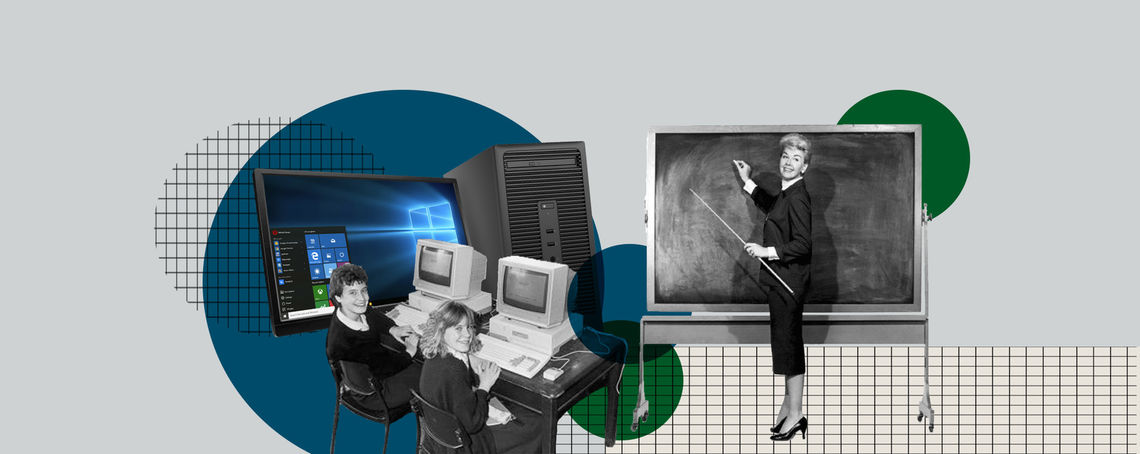
Կարդալ հայերեն
Thanks to the dedication of teachers, their ability to respond quickly to change, the efforts of different educational institutions and the Ministry of Education, Science, Culture and Sport, Armenia has been adopting different forms of distance learning for three weeks now.
On March 27, the Minister of Education, Science, Culture and Sport Arayik Harutyunyan spoke about the need for at least 24,000 pieces of additional equipment for about 10% of students and teachers currently excluded from the mainstream of distance learning in the country. On April 6, Prime Minister Nikol Pashinyan stated that he is proud of teachers’ work during the COVID-19 outbreak. "It turned out that the educational system of Armenia, not completely, but is about 80% ready to provide distance education," he said live on Facebook.
The impact of the COVID-19 epidemic on society is an opportunity to consider the technological infrastructure of the 1,360 state schools in Armenia and to reflect on the use of information and communication technologies (ICT) in the educational process.
What do we have?
According to the analysis of the National Center for Educational Technologies (NCET), every school in Armenia (as of the 2018-2019 academic year) is equipped with at least one desktop computer or laptop. There are a total of 20,385 computers in the country’s schools, 82% of which (16,807) are used for educational purposes. The schools have 658 interactive whiteboards, 1,716 projectors, 2,460 printers, 2,271 multifunction devices (printers and scanners), 1,214 scanners and 1,269 photocopiers.
Computers are mainly installed in designated computer labs designed for ICT learning. There is only one computer lab in 78.2% of schools, two in 11.8%, and three in 1.3% (ICT Needs Assessment in RA State Schools, 2019, NCET, page 14).
All schools in Armenia have at least one computer connected to the Internet. About 64% of schools have an internal network, of which 61% use a cable connection, 8.1% use Wi-Fi devices, and 30.8% use both.
In Armenia,
1. There are no laptops in 680 schools (50% of schools).
2. There are no projectors in 433 schools (32% of schools).
3. There are no computer labs in 112 schools (8% of schools).
4. 62.8% of school computers are Pentium 4 or lower.
5. Majority of schools have five desktop computers (mode of distribution).
6. There are no interactive whiteboards in 1,045 schools (76.8% of schools).
7. There is on average one desktop computer or laptop for every 23 students.
Where did Schools Get Their Equipment from?
The World Bank (WB) educational loan programs have been the main source of computer equipment provision to state schools in Armenia (Table 1). The following loan programs covered different years:
1. WB_98-02, "Education Financing and Management Reform Program," 1998-2002.
2. WB_04-09, "First Education Quality and Relevance Program," 2004-2009.
3. WB_09-15, "Second Education Quality and Relevance Program," 2009-2015.
4. WB_14-21, "Education Improvement Program," 2014-2021.
The WB educational loans have provided Armenian schools with computer labs with an average of four computers each and other equipment (multifunctional devices, power supplies) for administrative purposes. Armenia had only 2,200 computers across 300 schools prior to the launch of the WB_04-09 program. The WB-09-15 program provided computers for administrative purposes (to connect to the Education Management System) to 1,360 state schools in Armenia. Computer resource centers (labs) including laptop sets have been set up in 195 high schools.[1]

The WB "First Education Quality and Relevance Program" launched a “Computer Revolving Fund” aimed at achieving the goal of cost-effective and equal computer distribution in all state schools across Armenia in five year cycles.
-
Computer labs called "School Learning Centers", would be set up in the schools equipped with the necessary technology and electronic materials.
-
The Fund, with repetitive five-year cycles, would collect fees from students to cover the cost of equipment provision (estimated then at an average of $15 per student/per year) and/or maintenance.
-
In the first 5 years of the Fund’s operation, only 41.7% ($1.6 million) of the planned amount was collected.
The Computer Revolving Fund was closed down after the first five-year cycle in contrast to the "Textbook Revolving Fund" (now a foundation), which still provides textbooks on the same principle (i.e. for a fee), allowing for the publication of new textbooks.
At the end of the WB_04-09 program, the average per student distribution of computers in Armenia increased from 250 students/computer to 35 students/computer (see the Final Report of the First Education Quality and Relevance Program, Centre for Education Projects PIU, 2003-2009).
The Distribution of Equipment
Only 25% of state schools in Armenia have more than 14 computers, while 50% have only up to 8 computers in total. Meanwhile, there is a state school with 350 computers. The picture is almost the same with interactive whiteboards. 77% of schools do not have an interactive whiteboard, but there is a state school that has 31.
In Armenia (for the 2018-2019 academic year),
1. There is one projector for every 228 school students.
2. There is one interactive whiteboard for every 594 school students.
3. There is one desktop computer or laptop for every 23 school students.
In EU countries, for comparison, there is on average one computer or laptop for every 14 elementary students, one for every 7 lower secondary and one for every 8 upper secondary students. In countries with top results across various international educational assessments, these indicators are even more generous. In Finland and Estonia, for example, there is on average one desktop computer or laptop for every 3 upper secondary students. There is one interactive whiteboard for every 56 students at the elementary level, 169 lower secondary and 166 upper secondary level.
The relationship between computer access in schools, their use purposes and student learning outcomes requires, however, a separate analysis for better-argued technology provision in schools. Armenia’s TIMSS (Trends in International Mathematics and Science Study) 2011 results reveal, for instance, that students from schools, which had on average one computer for every 3-5 students, scored 5 points lower in the 8th grade math test (470 points) than those from schools with one computer for every 6 or more students (475 points). The same relationship is observed in the field of science: 3-5 students/1 computer - 438 points, 6+ students/1 computer - 444 points.
The Use of Equipment
The use of computers in schools needs further analysis. 97% of Armenian teachers, for example, mention using a computer during their teaching (see the "Sociological Research on Teachers’ Use of ICT in Armenian Public Schools", NCET, 2108). Their top three uses for the computers wereMicrosoft Word, Microsoft PowerPoint and the Internet. It is strange, however, that only 22.8% of teachers indicated use of Microsoft Word and only 18.1% the use of Microsoft PowerPoint. The rate of Internet use was even lower. In the last three years, usage rates for these tools have not changed significantly, except for an increase in the use of Microsoft Word (see Table 2). Almost 99% of respondents mentioned that they have sufficient or advanced skills to use the Internet, but only 17% mentioned using it in the educational process.
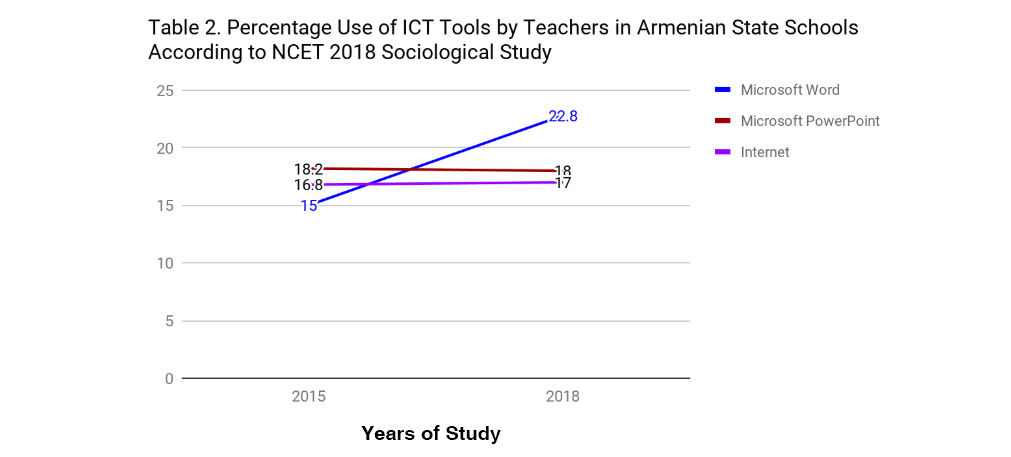
According to the same study, by 2018,
47.5% of teachers had never applied ICT for a distance class, presumably had never taught a distance lesson. Only 2% of teachers reported using ICT tools for a distance lesson every day (see Table 3).
99% of teachers stated that the use of ICT would, in their opinion, increase the quality of education.
According to 78.1% of teachers, the use of ICT in schools is an additional incentive for students to learn, as not everyone has a computer at home.
23% of teachers did not have a computer at home.
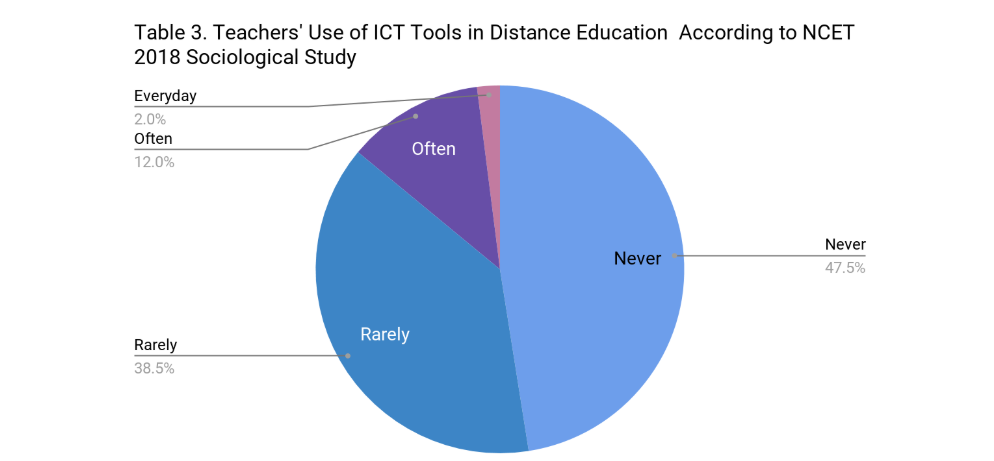
What Percentage of Students Have No Access to ICT Tools?
UNICEF's "Child Poverty in Armenia" 2016 study indicates that:
-
41.7% of children aged 6-14 do not have Internet access at home.
-
37.3% of children aged 6-14 do not have access to a computer at home.
According to the same study, 64% of children in Armenia are deprived in 2 or more dimensions (e.g. utilities, computer availability, etc.). Distribution of poverty indicators (housing problems, lack of computer and Internet at home) in Armenia according to settlement area is shown in Table 4.
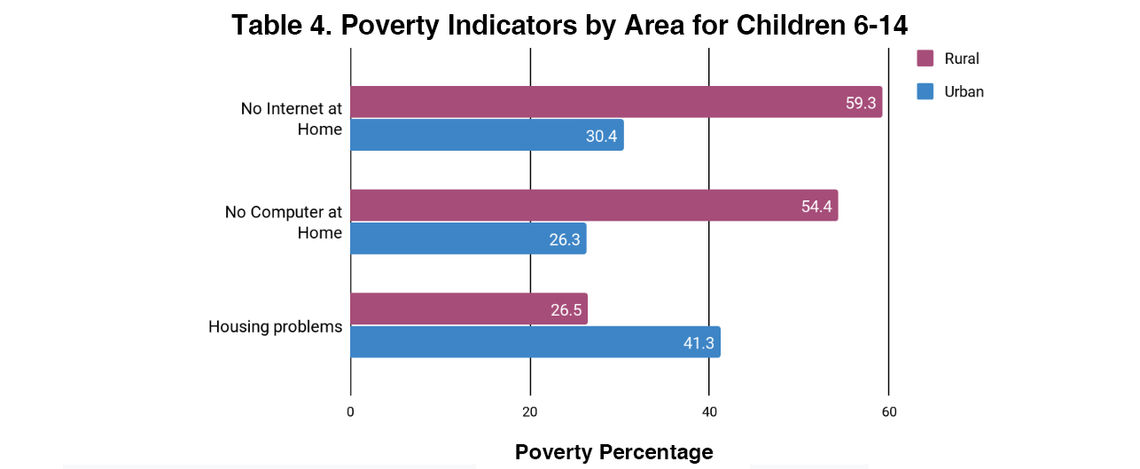
In Conclusion, I would make the following recommendations to policymakers:
1. Fund/conduct comprehensive research (including a phenomenological study) into the application of ICT in education/distance learning experience in the field of general education. Extensive monitoring data is important, but not sufficient. Data from the above-mentioned studies suggest that there is a need to understand how teachers and students perceive "ICT application in teaching" and "distance learning." A comprehensive, including qualitative, study would help to identify the target range of financial investments, to define the scope of effective training and targeted support for the use of ICT, to make sense of the current experience of online learning.
2. Fund/conduct comprehensive monitoring of the use of ICT in general education. NCET’s various studies on the use of ICT in Armenia’s state schools are very important initiatives. However, there is a need to collect/study much more comprehensive quantitative data, such as the European Commission's “2nd Survey of Schools: ICT in Education” which will allow us to fully describe the whole scope of “relationships.” It is also important to understand the relationship between school resources and educational processes/outcomes. TIMSS 2003-2015 assessment, for example, shows that, in the case of Armenia, the relationship between the school's resources and the students' results is not obvious.
3. Consider the possibility of relaunching a computer revolving scheme for schools. Perhaps the only immediate solution to addressing the current shortfall of 24,000 devices is to ask for donations. However, the system cannot always rely on donations. The school equipment revolving scheme can provide sustainability in supply and maintenance of technological school equipment. The European Commission’s “2nd Survey of Schools: ICT in Education” indicates that, in the European Area, 94% of schools’ technical maintenance is carried out by the school staff. In the case of Armenia, maintenance by school staff would mean recruitment for new jobs which, given the current wages, would hardly be attractive for qualified professionals. It is possible, however, to outsource maintenance to local companies, requiring them to involve local resources serving several communities. This can not only boost the number of better paid jobs, but also reduce the cost of the service unit to the state. As of the 2018-19 academic year, Armenian schools possessed 3,764 computers with technical problems and 629 with program malfunctioning, comprising 21.5% of the available computers.
2. Refrain from "luxury" expenses. The introduction of interactive whiteboards was considered an educational innovation in the early 2000s. The UK, for example, planned in 2015 to spend 27 billion to replenish all schools with interactive whiteboards. Armenia was also involved in this trend. 658 whiteboards were purchased, mainly on World Bank credit. However, since the mid-2000s, the majority of research on interactive whiteboards has been based on the study of assumptions, or at best, individual cases, which is not enough to prove their effectiveness. Die Gregorio's and Sobel-Lozhetsky's study of interactive whiteboards shows that 1) quantitative studies on their effectiveness often contradict each other; 2) their effectiveness depends on the school culture, teaching quality, curriculum and a few other factors. The maintenance of these whiteboards is a separate issue. Instead of purchasing these tools, which cost an average of $2,000-$5,000 and are therefore available to a small number of schools, it seems more sensible to purchase simple marker boards and projectors (average $500-$600) to expand the scope of student engagement. Armenia does not have to blindly mimic the steps of developed countries.
3. Develop guidelines/policy for technology application in the educational process. The European Commission's "Highly equipped and connected classroom” model seems to be a good example of policy modeling with three cases (including costs) to provide secondary students with technological media and content (computers, computer programs, Internet connectivity, e-learning platforms and teacher competencies). It also includes alternatives to state-provided equipment, such as "Bring Your Own Device." These, of course, are models which need to be studied in advance of planning a more targeted use of technological equipment in the educational process in Armenia. This point is effective though if the research proposed in the first two points is done.
-----------
1. The exact number of computers could not be ascertained, hence this figure is not reflected in Table 1.
also read
Distance Education in Times of Coronavirus
By Narek Manukyan
Educational institutions around the world are moving to online learning as the COVID-19 pandemic wreaks havoc. Narek Manukyan examines the Armenian education system’s preparedness for distance learning following the government’s announcement of a one-month state of emergency in the country.

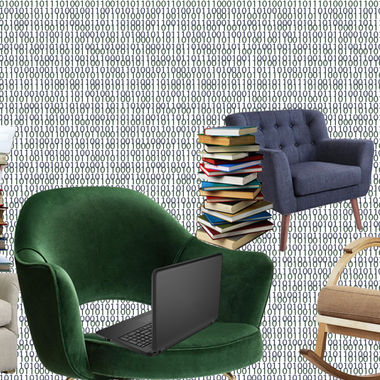


EVN Report welcomes comments that contribute to a healthy discussion and spur an informed debate. All comments will be moderated, thereby any post that includes hate speech, profanity or personal attacks will not be published.